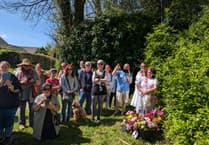LIT by a glowering sky, an enigmatic head stares sightlessly over the seas, lonely witness to an environmental crisis . . .
But this isn’t Easter Island – it’s the Rame Peninsula.
And the Polynesian figure was sculpted right here in South East Cornwall – from plastic found in the sea.
The figure was inspired by the huge heads, or moai, of Easter Island (Rapa Nui) made long before European explorers arrived there in the early 1700s.
The exact reasons for the decline of the islanders who made the mysterious figures are debated, but the traditional theory holds that they chopped down the island’s trees faster than they could regrow.
This resulted in soil erosion, loss of habitat and disappearing water sources, which made farming, boat-building, hunting and fishing ever more difficult, resulting in the population’s collapse.
Environmental artist Rob Arnold, from Liskeard, who made the figure, sees the tragedy of Easter Island as a metaphor for ‘the way we are devouring and polluting the resources of our entire planet at a rate far faster than they can be replenished’.
Rob’s work focuses on marine plastics, and particularly microplastics (fragments of plastic measuring less than 5mm) – the sort of plastic waste, with serious impacts on marine wildlife from plankton up to whales, that can now be found at the bottom of deep ocean trenches and locked into Arctic ice.
This scaled-down version of a moai is covered with small pieces of plastic harvested using a separation machine that Rob invented.
He has used it to sift many millions of microplastic fragments from a small section of sand on his local beach in South East Cornwall.
The sculpture’s base is carved from a huge polystyrene pontoon float, which was itself rescued from the beach as it started to break down into hundreds of thousands of tiny foam beads.
The art work was placed at Rame for a photocall to raise awareness of the pollution issues.
Rob said he hopes the piece will make us pause to remember the people who created the huge statues of Rapa Nui – ‘and how even the greatest of civilisations can collapse if they destroy the ecosystems upon which they depend’.





Comments
This article has no comments yet. Be the first to leave a comment.